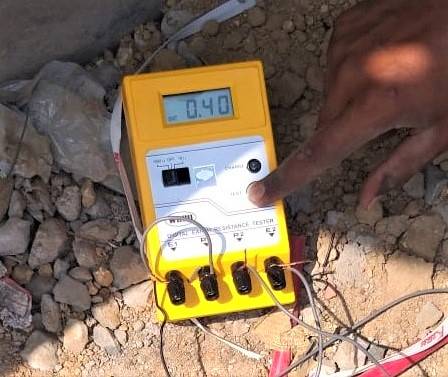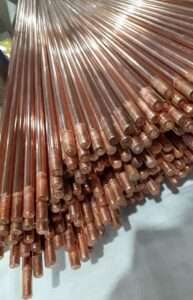The resistance offered by the earth electrode to the current flow into the ground is known as earth resistance. The ideal earth resistance is considered to be zero, such that there is a quick flow of fault current into the ground, but this is practically impossible. The earth resistance value is different in different locations. Earthing value as per Indian Standard gives a tolerable resistance value for different structures and is mainly depending on the soil resistivity.
According to IS 3043, the earthing resistance value is mainly dependent on three factors:
1) The resistance of the earth electrode
2) The soil resistivity
3) The contact resistance between the electrode surface and the soil
The other two factors are considered negligible compared to the soil resistivity therefore they are practically avoided. This is the reason why we mainly focus on soil resistivity measurement when we consider the earthing value as per Indian Standard. The resistance of the soil depends on different factors such as moisture content of the soil, chemical composition, concentration of salts dissolved in the water content, grain size and closeness of packing. Soil temperature also has importance in the soil resistivity value if it is very low and close to freezing temperatures.
Moist soil that can hold moisture throughout the year is preferable for the installation of earthing system. Wet marshy ground, clay, loamy soil land, arable land, or land with loam mixed with small quantities of sand, gravel and stones, peat etc are the best soil choices for earthing purposes. Land with entirely dry sand, gravel chalk, limestone, granite, and very stony ground should be avoided if possible.
Permissible Earth Resistance Value as per Indian Standard:
The permissible earth resistance values are identified with reference to the various base values specified in the Indian Electricity Rules:
– The recommended safe touch potential value is supposed to be 523 volts
– Ifault = maximum current in fault conditions
– Resistance = Touch voltage/Fault current
For a substation of 100 KVA transformer:
– Maximum Fault current = 100 * 100/4 = 2500 A, which can be taken as 2000A
– Then the permissible earth resistance value = 523/2000 = 0.26ohms
To obtain such a low value for earthing resistance, the quality of the earthing system must be excellent, and the expenditure will be very high. Hence a nominal value of 1ohm is taken for practical purposes. The following are the permissible resistance values for different facilities:
a) Power stations – 0.5 ohms
b) EHT stations – 1.0 ohms
c) 33KV substations – 2 ohms
d) DTR structures – 5 ohms
e) Tower foot resistance – 10 ohms
These are taken as the reference for permissible values for earthing resistance. Various methods are used to obtain a minimum resistance value. The usual practice is to deep drive the earth electrode below the ground level to get stable moist soil. Thus, the earth resistance value remains unaltered even when the upper layers of the soil are dried out. At times, it is identified that the earth resistance value does not improve enough even if the electrodes are buried deep inside the soil. This is because the soil resistivity is very high at such locations. In such cases, we can use salt, charcoal or chemical earthing compounds to bring down the earth resistance value to the desired level.
Techniques for Reducing Soil Resistivity:
Soil treatment is the way to minimize earth electrode contact resistance in special or difficult locations. Previously, common salt and charcoal were used to fill earth pits to reduce soil resistivity and increase moisture content. Further, Bentonite or Marconite is used in rocky and hard terrain to reduce soil resistivity to a larger extent compared to salt and charcoal. In all cases such as deep driven vertical electrodes and earthing strips that are laid radially, bentonite and marconite increase the contact efficiency of the electrode with the ground.
It is to be noted that high moisture content does not ensure low soil resistivity. At times, it is seen that earth electrodes driven directly in river beds or streams show very high earth resistance. If the water is pure the resistivity can be high unless the soil contains sufficient elements to form a conducting electrolyte. The high moisture content or water availability can help increase the solubility of existing natural elements or artificially introduced compounds to improve soil conductivity.
Another means to increase the earthing capacity is to increase the number of earthing electrodes. But at times even this seems to fail. This usually happens in the case of soils with extremely high resistivity. The easiest and immediate method to reduce the soil resistivity in such cases according to IS 3043 is to dissolve substances like sodium chloride ( NaCl), calcium chloride ( CaCl ), sodium carbonate ( Na2CO3 ), copper sulphate ( CuS04 ), salt, and soft coke, and salt and charcoal in suitable proportions. With average or high moisture content, these agents form a conducting electrolyte surrounding the earth electrode.
Conclusion:
The earth resistance value of a place is measured and compared with the expected standard values before designing the earthing system. The earthing system design is done to maintain this earthing value as per Indian Standard. On basis of the resistance value, simple soil treatments are done during implanting the earth electrode into the ground. Salt and other earthing compounds are applied in the earthing pit or surrounding the electrode. Then the basin is filled with water several times, and the soil is allowed to be soaked. Thus a cylindrical space around the entire length of the earthing electrode becomes wet with water. This significantly improves the earth resistance of the electrode.
Generally, this improved conductivity of soil lasts for many years. But still, it is recommended to measure the earth resistivity of the electrode yearly or half-yearly and take necessary action towards re-treatment of the soil if the resistivity is increased above the desired value.
Thank you for reading the blog, Axis is a leading manufacturer and supplier of Electrical Components to over 80+ Countries. Talk to our industry expert by visiting our contact us section. You can also watch our videos by our experts – click here.









